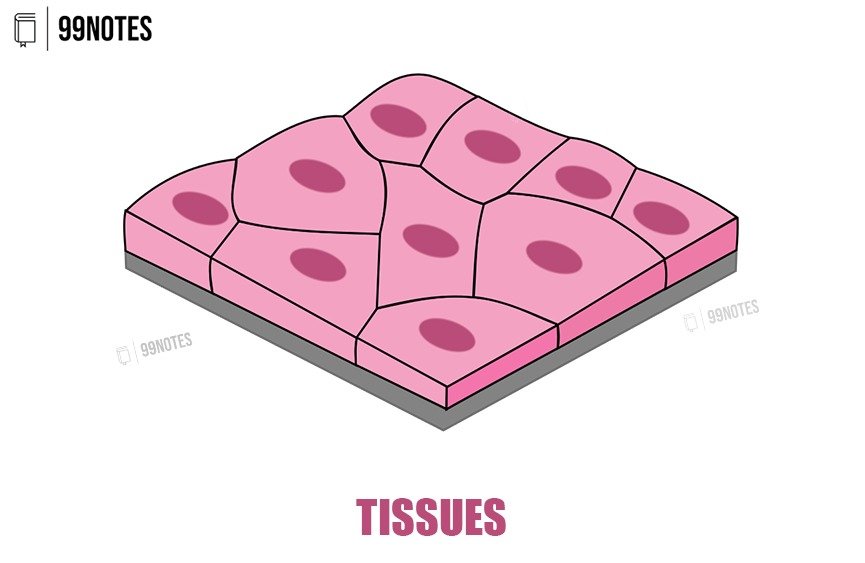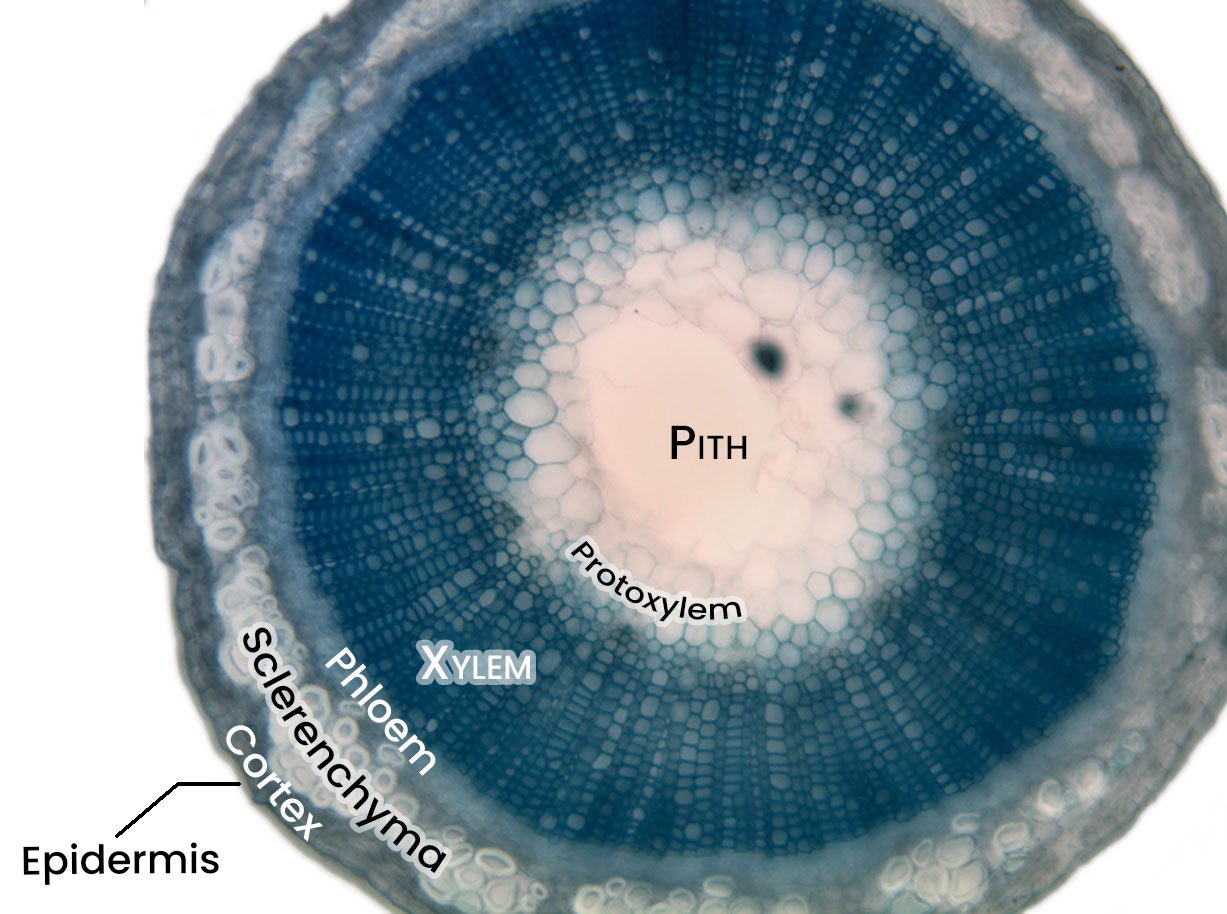Tissues
A group of cells that are similar in structure and/or work together to achieve a particular function forms a tissue.
Plant Tissues:
Plant tissues can be of two types: Meristematic Tissue (dividing tissue) and Permanent Tissue.
Meristematic Tissue: 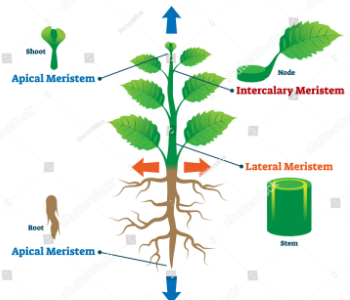
Dividing tissue – growth tissue. Depending on where it is present it is classified as:
- Apical: Present in growing tips of stems & roots & increases the length of stem/root.
- Lateral: Responsible for increasing the girth of stem/root.
- Intercalary: At the base of leaves or internodes (on either side of the node) on things.
New cells produced by meristem are initially like meristem itself, but as they grow and mature, their characteristics slowly change and they become differentiated as components of other tissues.
Permanent Tissue:
Meristem take up different roles and lose their ability to divide. The process called differentiation-Meristem differentiates to form different kinds of permanent tissue:
- Simple Permanent Tissues
- Complex Permanent Tissues
Simple Permanent tissue:
Made of one type of cell, which looks like each other. 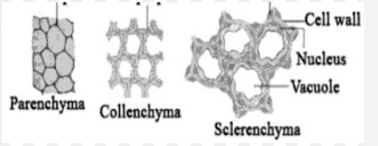
- Parenchyma: The basic packing tissue.
- It contains relatively unspecialised cells with thin cell walls.
- They are live cells & very loosely packed, intercellular spaces are found in this tissue.
- Provides support to plants & also stores food.
- In some situations chlorophyll = chlorenchyma(type of parenchyma)
- In aquatic plants, large air cavities are present in parenchyma to give buoyancy to plants and help them float. These tissues are called aerenchyma.
- The parenchyma of stems & roots stores nutrients & water.
- Collenchyma: Flexibility in the plant is due to (bending without breaking).
- Found in leaf stalks below the epidermis (first skin).
- Cells of this tissue are elongated & thickened at the corner and have very little intercellular space.
- Sclerenchyma: It makes plants hard & stiff. For example, Husk of coconut.
- Cells of this tissue are dead.
- They are long & narrow as the walls of thickened due to lignin (a chemical substance which acts as cement).
- Often walls are so thick that there is no internal space inside the cell.
- It provides strength to plants.
- It is present in stems around vascular bundles, in the veins of leaves & hard covering of seeds & nuts.
Epidermis:
The Epidermis in plants is made of a single layer of cells (In dry habitats thicker protection against water loss). It covers the entire surface and all parts of the plant. Forms a continuous layer without intercellular spacing: since it has a protective role to play.
- Epidermal cells on areal parts of plants often secrete a waxy, water-resistant layer on their outer surface. This aids in protection against loss of water, mechanical injury & invasion by parasitic fungi.
- Shape: most are relatively flat; Often outer & side walls are thicker than inner walls.
- Leaf: Stomata: The Epidermis of the leaf has these pores, enclosed by two kidney-shaped guard cells. [Guard against transpiration loss].
- Roots: function: to absorb water; Commonly bear long hair-like parts that greatly increase the total absorptive surface area.
- As a plant grows older, the outer protective tissue undergoes certain changes. A strip of secondary meristem replaces the epidermis of the stem. Cells on the outside are cut off from this layer. This forms the several-layer thick bark of the tree (or cork).
- Cork has a chemical called suberin in their walls, which makes it impervious to gases & water.
Complex Permanent Tissue:
Made of more than one type of tissue. They coordinate & perform a function. For example, Xylem and Phloem are conducting tissues & constitute a vascular bundle. (a distinctive feature in complex plants)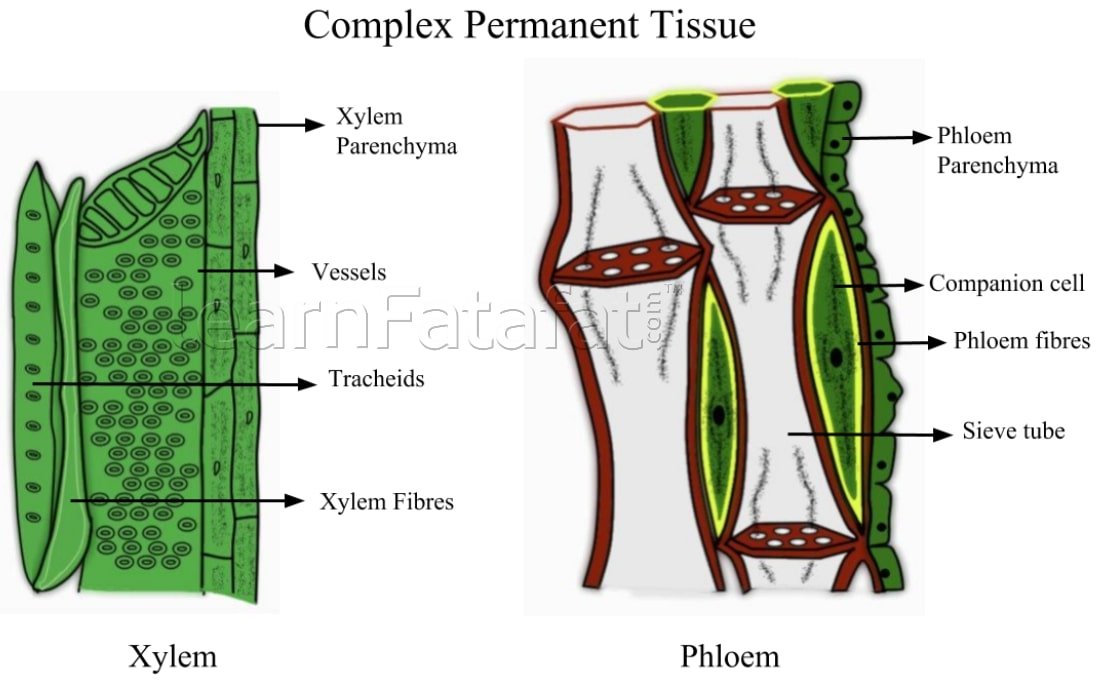
- Xylem: Consists of tracheids, vessels, xylem parenchyma & xylem fibres.
- The cells have thick walls & many of them are dead.
- Tracheids & vessels are tubular structures that transport water and minerals vertically. But in one direction.
- Parenchyma stores food & helps in the sideways conduction of water.
- Fibres are mainly supportive in function.
- Phloem: Made of 4 elements: Sieve tubes, companion cells, phloem fibres and Phloem parenchyma.
- Sieve tubes are tubular cells with perforated walls. Material can move in both directions. The phloem transports food from leaves to other parts of the plant.
- Except for phloem fibres phloem cells are living cells.
Animal Tissues:
Epithelial Tissue:
It is the covering or protective tissue in an animal’s body. It covers most organs and cavities within the body. It forms a barrier to keep the different systems of the body separated. Examples are skin, the lining of the mouth, the lining of blood vessels, lung alveoli, and kidney tubules.
- They are tightly packed and form continuous sheets.
- Small cementing material in them and have no intercellular space.
- The permeability of cells of various epithelia plays an important role in regulating the exchange of material between the body and the external environment and between different parts of the body.
- Regardless of type, all epithelium is usually separated from the underlying tissue by an extracellular fibrous basement membrane.
Different epithelia show different structures (to vary permeability & strength) that correlate with their unique functions. 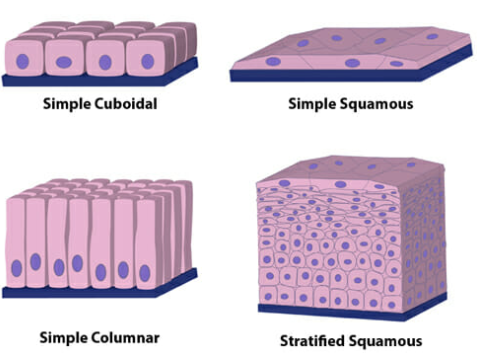
- Simple Squamous. It is an extremely flat and thin epithelium, with a delicate lining. Selectively permeable surfaces; for example, Blood Vessels, Lung alveoli, and oesophagus.
- Stratified Squamous: Squamous epithelial arranged in layers to prevent wear and tear. For example, the Skin of our body, and the lining of our mouth.
- Columnar Epithelial: Where absorption & secretion occur, tall epithelial cells facilitate the movement epithelial barrier. For Example, the lining of the intestine and respiratory tract (tissue also has cilia: hair-like projections on its outer surface- move to push mucus forward to clear it)
- Cuboidal Epithelial: Forms lining of the kidney and ducts of salivary glands, where it provides mechanical support.
Epithelial cells often acquire additional specialisation as gland cells, which can secrete substances at the epithelial surface. Sometimes a portion of epithelial tissue folds inwards, and a multicellular gland is formed. = Glandular Epithelium or Glands.
Connective Tissue:
Cells of connective tissue are loosely spaced & embedded in an intercellular matrix. The matrix may be jelly-like, fluid, dense or rigid. The nature of the matrix differs in concordance with the function of particular connective tissue. 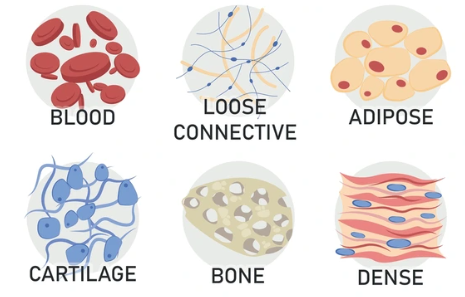
- Example, Blood: It has a fluid matrix called plasma;
- RBCs, WBCs & platelets are suspended in it.
- Plasma contains proteins, salts & hormones.
- It flows & transports gases, digested food, hormones, and waste materials to different parts of the body.
- Bone: Bone cells are embedded in a hard matrix that is composed of calcium & phosphorus compounds.
- It forms a framework that supports the body. It anchors the muscles & supports the main organs of the body.
- It is strong & Non-flexible tissue.
- Two bones can be connected by connective tissue = (very elastic, considerable strength, contains very little matrix)
- Tendons: Connect bones to muscles. Fibrous, great strength, but limited flexibility.
- Cartilage: Solid matrix composed of protein & sugars
- Very widely spaced cells. Highly flexible.
- Smoothens bone surfaces at joints.
- Present in nose, ear, trachea, & larynx.
- Areolar Connective tissue: found between skin & muscles, around blood vessels & nerves & in the bone marrow. It fills space inside organs, supports internal organs & helps in the repair of tissues.
- Adipose Tissue: Fat-storing tissue. Found below skin & internal organs. The cells of this tissue are filled with globules. Also acts as an insulator.
Muscular Tissue:
Contain special protein = contractile proteins – contracts & relaxes to cause movement. 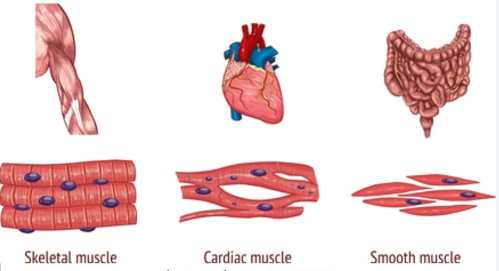
- Voluntary Muscle (also called skeletal muscle): We can move on will.
- Shape: Under a microscope, alternate light and dark bands or striations when strained properly. These are also called Striated Muscles. The cells of this tissue are long, cylindrical, unbranched and multinucleate (many nuclei).
- Involuntary Muscles: Found in the Iris of the eye, ureters (kidney to bladder), muscle alimentary canal, and blood vessels movement by the heart (Cardiac Muscle).
- Shape: long cells with pointed ends (spindle-shaped) & uninucleate (single nuclei). Also called Unstriated muscle.
- Cardiac muscles are striated, not pointed at the end, having many nuclei but are involuntary.!!
Nervous Tissue:
Highly specialized for being stimulated & then transmitting the stimulus very rapidly from one place to another within the body. 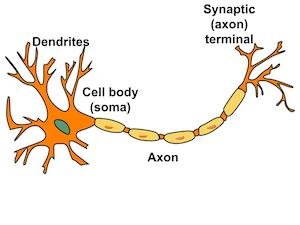
- The brain, spinal cord & nerves are composed of nervous tissue. Cells = nerve cells or neurons.
- Neuron: Consists of nucleus and cytoplasm, from which long thin hair-like parts arise. Usually, each neuron has a single long part called axon, and many short, branched parts called dendrites. Can be a metre long.
- Many nerve fibres bound together by connective tissue make up a nerve.

